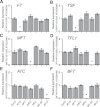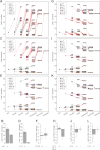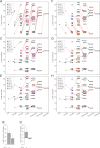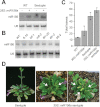Generation and analysis of a complete mutant set for the Arabidopsis FT/TFL1 family shows specific effects on thermo-sensitive flowering regulation
- PMID: 23404901
- PMCID: PMC3617836
- DOI: 10.1093/jxb/ert036
Generation and analysis of a complete mutant set for the Arabidopsis FT/TFL1 family shows specific effects on thermo-sensitive flowering regulation
Abstract
The FLOWERING LOCUS T (FT)/TERMINAL FLOWER 1 (TFL1) family proteins play an important role in the regulation of flowering time. In the Arabidopsis thaliana genome, there are six genes in the FT/TFL1 family. To determine how these FT/TFL1 family genes contribute to the regulation of flowering time, this study generated a comprehensive set of mutants (sixty-three multiple mutants in all combinations) of the FT/TFL1 family genes and analysed their flowering times at 23 and 16°C under long-day conditions. The analysis confirmed that FT and TFL1 are major determinants of flowering time under long-day conditions. At 23 °C, ft-10 tsf-1 mft-2 showed the latest flowering, whereas tfl1-20 atc-2 bft-2 showed the earliest flowering. Flowering occurred in the sextuple mutants. Introduction of tsf-1 led to reduced sensitivity to ambient temperature change. Introduction of tfl1-20 caused a stronger effect in accelerating flowering time at 16 °C than at 23 °C. Overexpression of miR156 did not block flowering of sextuple mutants, suggesting that there is a pathway to induce flowering independent of the FT/TFL1 pathway and miR156 pathway. This study proposes that this mutant population will be useful in further investigation of the functions of the FT/TFL1 family genes in plant development.
Figures







Similar articles
-
The alleles at the E1 locus impact the expression pattern of two soybean FT-like genes shown to induce flowering in Arabidopsis.Planta. 2011 Nov;234(5):933-43. doi: 10.1007/s00425-011-1450-8. Epub 2011 Jun 17. Planta. 2011. PMID: 21681526
-
Genetic interactions reveal the antagonistic roles of FT/TSF and TFL1 in the determination of inflorescence meristem identity in Arabidopsis.Plant J. 2019 Aug;99(3):452-464. doi: 10.1111/tpj.14335. Epub 2019 May 17. Plant J. 2019. PMID: 30943325
-
The microRNA156-SQUAMOSA PROMOTER BINDING PROTEIN-LIKE3 module regulates ambient temperature-responsive flowering via FLOWERING LOCUS T in Arabidopsis.Plant Physiol. 2012 May;159(1):461-78. doi: 10.1104/pp.111.192369. Epub 2012 Mar 16. Plant Physiol. 2012. PMID: 22427344 Free PMC article.
-
The FLOWERING LOCUS T/TERMINAL FLOWER 1 Gene Family: Functional Evolution and Molecular Mechanisms.Mol Plant. 2015 Jul;8(7):983-97. doi: 10.1016/j.molp.2015.01.007. Epub 2015 Jan 15. Mol Plant. 2015. PMID: 25598141 Review.
-
Molecular regulation of plant developmental transitions and plant architecture via PEPB family proteins: an update on mechanism of action.J Exp Bot. 2021 Mar 29;72(7):2301-2311. doi: 10.1093/jxb/eraa598. J Exp Bot. 2021. PMID: 33449083 Review.
Cited by
-
A Predictive Model for Time-to-Flowering in the Common Bean Based on QTL and Environmental Variables.G3 (Bethesda). 2017 Dec 4;7(12):3901-3912. doi: 10.1534/g3.117.300229. G3 (Bethesda). 2017. PMID: 29025916 Free PMC article.
-
Characterization of PEBP-like Genes and Function of Capebp1 and Capebp5 in Fruiting Body Regeneration in Cyclocybe aegerita.J Fungi (Basel). 2024 Jul 31;10(8):537. doi: 10.3390/jof10080537. J Fungi (Basel). 2024. PMID: 39194863 Free PMC article.
-
Comparative analysis of miRNA and mRNA abundance in determinate cucumber by high-throughput sequencing.PLoS One. 2018 Jan 5;13(1):e0190691. doi: 10.1371/journal.pone.0190691. eCollection 2018. PLoS One. 2018. PMID: 29304061 Free PMC article.
-
Characterization of FLOWERING LOCUS T1 (FT1) gene in Brachypodium and wheat.PLoS One. 2014 Apr 9;9(4):e94171. doi: 10.1371/journal.pone.0094171. eCollection 2014. PLoS One. 2014. PMID: 24718312 Free PMC article.
-
Changing the spatial pattern of TFL1 expression reveals its key role in the shoot meristem in controlling Arabidopsis flowering architecture.J Exp Bot. 2015 Aug;66(15):4769-80. doi: 10.1093/jxb/erv247. Epub 2015 May 27. J Exp Bot. 2015. PMID: 26019254 Free PMC article.
References
-
- Abe M, Kobayashi Y, Yamamoto S, Daimon Y, Yamaguchi A, Ikeda Y, Ichinoki H, Notaguchi M, Goto K, Araki T. 2005. FD, a bZIP protein mediating signals from the floral pathway integrator FT at the shoot apex. Science 309, 1052–1056 - PubMed
-
- Alonso JM, Stepanova AN, Leisse TJ, et al. 2003. Genome-wide insertional mutagenesis of Arabidopsis thaliana. Science 301, 653–657 - PubMed
-
- Blazquez MA, Ahn JH, Weigel D. 2003. A thermosensory pathway controlling flowering time in Arabidopsis thaliana. Nature Genetics 33, 168–171 - PubMed
-
- Bradley D, Ratcliffe O, Vincent C, Carpenter R, Coen E. 1997. Inflorescence commitment and architecture in Arabidopsis. Science 275, 80–83 - PubMed
Publication types
MeSH terms
Substances
LinkOut - more resources
Full Text Sources
Other Literature Sources
Molecular Biology Databases
Research Materials

